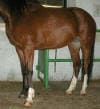
Naturalhorsetrim Listserv Photo Archives
(Click on thumbnail photos to see larger version.)
Thermography of a lame 6-year-old Arab mare:
Left:
Comparison between fronts and hinds, seen from behind (blood flow through
heels and bulbs).
Blood flow through bulbs is similar in fronts and hinds.
(Hot area on right front leg is not inflammation, but from shaved hair that has been
removed for ultrasonic examination)
Right: Comparison
between fronts and hinds, seen from in front of the horse.
Blood flow through toe and coronary is
reduced in both fronts compared to hinds.
Below: Lateral
view of hinds (left) and fronts (right). Blood flow through bulbs is similar,
while toe area is much
cooler in fronts
Above: left hind hoof--Good blood flow also in sole area.
Above, left front hoof--Good blood flow in bulbs and bars, but reduced in sole.
Below are pictures of the right front hoof:
After my discussion with the vet, he recommended lowering the heels, which the farrier did, and leaving the horse barefoot. According to the vet, the horse was much better after lowering the heels, and moved more freely. (I was not present; it would have been a good opportunity to check blood flow again.)
After 1 month, the owner put shoes back on.
The images indicate clearly that in this horse's front feet, the upper branch of the blood supply is open and blood flow to the bulbs and bars is o.k., while blood supply to the toe area is very much reduced. This area is supplied by the main branch that is running through the navicular bone.
The images were taken about 2 days after taking off the shoes. The reduction of blood flow is therefore not due to shoes, but might be due to the following reasons:
More comments from Sonja on interpreting thermographic images:
It is amazing what you can see with thermography, but interpretation on the hoof is usually tricky, as there is an overlaying effect of:
- heat, e.g. by inflammation or better blood flow
- insulation, e.g. by thicker horn or stretched lamellae.
So, if a horse has pain in one foot that is not from inflammation, this hoof may actually appear colder than the others because there is no load on it. On the images of this lame horse, though, the difference between bulbs and toe area is striking, and shows the blocking of blood flow specifically to the toe.
In conventional literature, navicular is blamed on bad blood flow as a cause. Well - we know that it is not the bad blood flow that is causing the decay of the navicular bone, but the blood pressure of the pinched artery, and this is caused by the high heels that in turn cause the heel pain diagnosed as navicular.
How can we scientifically prove it?
By the way - I have looked at shod and unshod horses, and didn't see much difference in temperature. When I got my lame navicular (and already shod 1 year) 3-year-old gelding, though, I remember that he had long heels and cold feet. We started with the usual treatment - Isoxuprine - but after a few weeks Peter Speckmaier CSHS came and opened our eyes. That was 2 years ago. Since then much has gone wrong due to the food, so now we're fighting back from rotated coffin bones and bad laminar connection. Progress of my horses recently is thanks to the information about magnesium on the naturalhorsetrim site!
For more information:
Sonja Appelt
Eibenweg 1
A-9241 Wernberg
Austria
sonja.appelt@omya.com
Back to Naturalhorsetrim list photo
archives
Back to Treating Founder
without Horseshoes Homepage
Copyright by Gretchen Fathauer, 2013 All rights reserved.